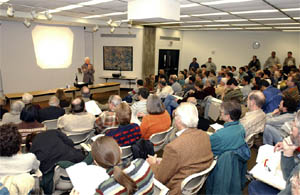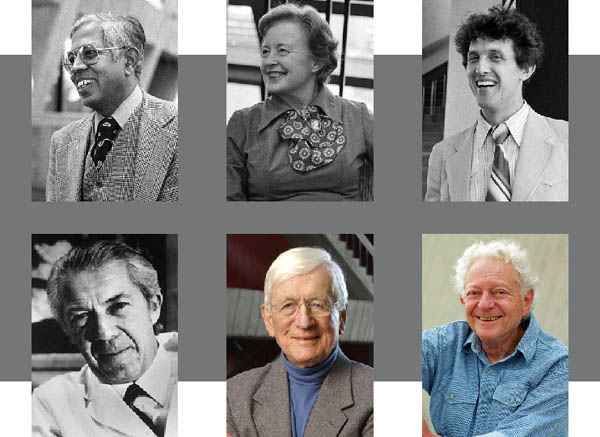 |
|
Colloquium Series by Mike Perricone The history of the science colloquium (from the Latin, "to talk together") probably extends back as far as the history of science itself.
Carrigan is a longtime organizer of the Fermilab Colloquium Series on Wednesday afternoons. But apparently, it took a while to shake things into place at the early days of the National Accelerator Laboratory. In June 1973, then-Deputy Director Ned Goldwasser wrote a memo to Art Roberts in the Physics Department (now the Particle Physics Division) saying, "the weekly colloquium did not provide, as well as it should, the Laboratory's central, general physics gathering point. This series will probably be commenced on a regular basis next September or October." Roberts countered: "As you know, I didn't appoint the present colloquium committee; my predecessor did." Roberts then appointed John Peoples to chair a new colloquium committee, and the Wednesday afternoon gathering began to evolve into a fixture of the lab culture. "Actually, 1973-74 was pretty chaotic around here with Wilson Hall not yet completed," said Peoples, who went on to serve as the lab's third director from 1988 to 1999. "We were searching for the right venue. The conference rooms in the Village were small. I remember we put folding chairs on the cement floor in Ramsey Auditorium before it was finished, but the auditorium was too big. Even a couple of hundred people would get lost in Ramsey Auditorium. When Wilson Hall was topped off, and when the One West conference room was completed, the Colloquium was able to settle in on a regular basis."
The series strives for a mix of physics and non-physics, at both the expert and general public levels. The topics have ranged from weather on brown dwarf stars to the physics of the blues, from semiconductor spintronics to Native American artifacts found at the lab. Current Colloquium chair Michael Albrow also noted striking parallels offered by two Colloquium presenters from very different fields on consecutive weeks. "Andrei Linde, one of the originators of the inflationary theory of the Big Bang, spoke on how the universe—or the part of the universe we see—originated 13.7 billion years ago from a singularity, a speck billions of times smaller than a single proton," Albrow said. "The next week, Christian De Duve, a Nobel Laureate in medicine (1974), spoke on the singular origin of life: how all the life we know originated about four billion years ago with the first self-replicating molecule in some primeval 'soup' of organic molecules. One week, the origin of the universe from a single point, and the next, the origin of life from a single molecule, in presentations from two very distinguished scientists." Still to come in 2004: Chris Morris of Los Alamos National Laboratory offers a talk on Jan. 7 with implications for national security, "The Use of Muons for Scanning Cargo." February offers the potential for a synergy similar to the "singularity" presentations of Linde and De Duve, with J. D. Bjorken speaking on "The Classification of Universes" followed a week later by Spencer Wells of the National Geographic Society on "The Past Within Us: Tracing our Genetic History." And in March, Nobel Laureate and Fermilab director emeritus Leon Lederman will again bring his distinctive style—and humor, no doubt—to Wednesday afternoon in One West. The Fermilab Colloquium Series is open to the public (enter at the west gate for security check and badging). The 2004 schedule is available on the Web, where more than 100 presentations have been archived and are available through streaming video on the website of Fermilab's Visual Media Services. (Special thanks to lab archivist Adrienne Kolb for unearthing the early memoranda) On the Web:
Fermilab Colloquium
Visual Media Services |
| last modified 12/31/2003 email Fermilab |
FRLsDFx9eyfrPXgV

